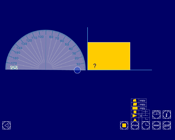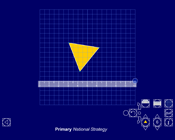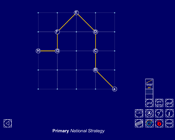Consolidation and practice
These resources are to support children in guided or independent work.
Calculating angles

This interactive teaching program (ITP) is an ICT-based tool to support the exploration of angles. Calculating angles ITP allows the child or teacher to represent single or multiple shapes rotated around a central point in one, two or four quadrants. The size of angles can be estimated or calculated and confirmed using the on-screen protractor or reveal function.
Polygon

This interactive teaching program (ITP) is an ICT-based tool to support the exploration of shape, space and measure. Polygon ITP allows the child or teacher to represent regular polygons with three to ten sides. The ITP can then be used to explore the properties of regular and irregular shapes by dragging vertices and creating additional vertices. The ITP includes an on-screen protractor and ruler.
Fixing points

This interactive teaching program (ITP) is an ICT-based tool to support the exploration of shape and space. Fixing points ITP allows the child or teacher to create one or more shapes by connecting a number of vertices on a grid. Angles can be estimated and measured, and the effect of moving different vertices can be explored.
Opportunities to use and apply
Possible contexts include:
- money, e.g. The agent’s fee for selling a house is 5%. Calculate the fee on a house sold for £80 000. How did you calculate the fee?
- looking for examples of and asking questions about percentages in everyday life, e.g. Use local newspaper advertisements to work out how much money you are saving after a percentage discount.
- data handling, e.g. collect data from 36 people, use a data-handling software package to present this as a pie chart and respond to questions about the percentage represented by each section of the pie chart.
Confirming learning
Ask probing questions such as:
- Kate says: 'To find 10% of an amount, you divide it by 10. So to find 20% of an amount, you divide it by 20.' Is Kate correct? How do you know?
- What calculations would you do to find 15% of £150?
- When finding percentages of quantities, what percentage do you usually start from? How does this percentage help you work out other percentages?
- Tell me two amounts where one is 25% of the other. Can you think of an example where one of the amounts is 80? How many possibilities are there?
 Calculating
Calculating


